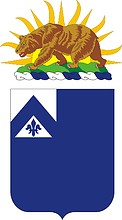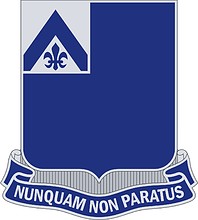7th Infantry Battalion and Regiment, National Guard of California, 1885 - 1917
On 22 July 1885, the 7th Infantry Battalion was constituted in the California National Guard by consolidating existing companies in Los Angeles and San Diego. On 5 May 1888, the 7th Infantry Battalion was expanded, reorganized, and redesignated as the 7th Infantry Regiment. On 7 November 1895 the 7th Infantry Regimen was consolidated with the 9th Infantry Regiment, which had been organized on 8 February 1890 in the National Guard of California, and the consolidated unit was designated as the 7th Infantry Regiment.
On 9 May 1898, the 7th Infantry Regiment was mustered into federal service at the Presidio of San Francisco, California, as the 7th Infantry Regiment, California U.S. Volunteers. On 2 December 1898, the regiment mustered out of federal service at Los Angeles.
On 29 June 1916, the 7th Infantry Regiment was mustered into federal service for duty on the Mexican Birder at Sacramento. On 11 November 1916, the regiment was mustered out of federal service at Los Angeles. On 5 August 1917, the 7th Infantry Regiment was drafted into federal service. From 25 September 1917 through 1 November 1917, the 7th Infantry Regiment was consolidated with the 2nd Battalion, Companies L and M, and the Sanitary Detachment of Northern California's 2nd Infantry Regiment. The consolidated unit was reorganized and redesignated as the 160th Infantry Regiment and assigned to the 40th Division.
On 3 March 1941, the 160th and 185th Infantry Regiments, forming the 80th Infantry Brigade of the 40th Division, were inducted into federal service at home stations. The brigade then moved to its mobilization station at the newly redesignated and enlarged Camp San Luis Obispo. In February 1942, the 40th Division was reorganized from at "square" division of four intantry regiments organized into two infantry brigades into a "triangular" division of three infantry regiments (159th, 160th and 185th Infantry Regiments)..
On 1 September 1950, the 40th Infantry Division was again called into active federal service for the Korean War. Shipping out of Oakland and San Francisco, California in late March 1951, the division deployed to Japan for training. For the next nine months, they participated in amphibious, air transportability, and live fire training from Mount Fuji to Sendai. On 23 December, the division received alert orders to move to Korea. The division moved to Korea in January 1952. After additional training, the division moved north in February 1952, where it relieved the 24th Infantry Division on the battle line. At the time the division consisted of the 160th, 223rd, and 224th Infantry Regiments, and smaller non-regiment-sized units.
In Korea, the 40th Infantry Division participated in the battles of Sandbag Castle and Heartbreak Ridge. In these campaigns, the division suffered 1,180 casualties, including 311 who were killed in action, and 47 who later died from wounds received in action.[1] Total division casualties in Korea included 376 killed in action, 1,457 wounded in action, and 47 dead of wounds. After the division was sent back to Japan, its time in Korea was commemorated by the commissioning of a punchbowl created by a local silversmith, by some accounts made up of the melted down Combat Infantryman Badges of the divisions veterans, with the geography of Heartbreak Ridge etched inside the bowl. It was used at ceremonial functions until it was stolen, and was subsequently bought at a garage sale by a married couple, who kept it for 18 years. It was then recovered and is now displayed at the Headquarters of the 40th Infantry Division, Joint Forces Training Base Los Alamitos, and is registered in the National Archives.
- 223rd Infantry Regiment: The 2nd battalion, 223rd Infantry Regiment was
withdrawn and consolidated with the 3rd Battalion, 111th Armored
Cavalry (organized and federally recognized 26 January 1951 with
headquarters at Van Nuys). The consolidated unit reorganized
and redesignated as the 139th Tank Battalion, an element of the
40th Armored Division, with headquarters at Burbank.
- 224th Infantry Regiment: The 2nd battalion, 224th Infantry Regiment, was withdrawn, reorganized, and redesignated as the 133rd Tank Battalion, an element of the 40th Armored Division, with headquarters at Riverside.
- 160th Infantry Regiment:. The 3rd battalion, 160th Infantry Regiment was withdrawn, reorganized, and redesignated as the 111th Reconnaissance Battalion, an element of the 40th Armored Division, with headquarters at Inglewood.
- 140th Tank Battalion: On 3 December 1941, Company A, 640th Tank Destroyer
Battalion was constituted in the Army of the United States. On
19 December 1941, the company was activated at Camp San Luis
Obispo, California, with personnel from the 143rd Field Artillery,
California National Guard. On 13 January 1946, the company was
inactivated at Camp Anza, California. On 15 March 1949, the company
was reorganized and federally recognized in the California Army
National Guard as the 140th Heavy Tank Battalion with headquarters
at Barstow and assigned to the 40th Infantry Division (later
redesignated as the 40th Armored Division). On 1 September 1950,
the battalion was ordered into active federal service at home
stations. On 2 September 1952, the battalion was reorganized
and federally recognized as the 140th Tank Battalion with headquarters
at Barstow. On 14 April 1953, the headquarters was relocated
to Pasadena. On 30 June 1954, the battalion was released from
active federal service and reverted to state control; concurrently,
federal recognition was withdrawn.
- 134th Tank Battalion. On 13 July 1946, the 109th Cavalry Reconnaissance Squadron, Mechanized was constituted in the California National Guard. On 18 September 1947, the squadron was organized and federally recognized as the 109th Mechanized Cavalry Reconnaissance Squadron with headquarters at Imperial. On 15 September 1949, the squadron was reorganized and redesignated as the 1st Battalion, 111th Armored Cavalry. On 15 December 1950, the headquarters was relocated to El Centro. On 1 July 1954, the battalion was reorganized and redesignated as the 134th Tank Battalion and assigned to the 40th Armored Division.
On 1 May 1962, the 6th and 7th Medium Tank Battalions were added to the regiment through a reorganization.
- 2nd Battalion, 185th Infantry,
expanded and reorganized March-April 1930 as the 2nd and 3rd
Battalions, 185th Infantry
Inducted into Federal service 3 March 1941 at home stations Inactivated 7 April 1946 at Camp Stoneman, California
Expanded and reorganized 5 August 1946 as the 223rd and 224th Infantry and assigned to the 40th Infantry Division (185th Infantry later reorganized with new 2nd and 3rd Battalions - hereafter separate lineage).
- 223rd Infantry organized and Federally recognized 15 October 1946 with Headquarters at Pasadena.
Ordered Into active Federal service 1 September 1950 at home stations.
(223rd Infantry [NGUS] organized and Federally recognized 2 September 1952 with Headquarters at Pasadena).
Released 30 June 1954 from active Federal service and reverted to state control; Federal recognition concurrently withdrawn from the 223rd Infantry (NGUS).
2nd Battalion withdrawn 1 July 1954 and consolidated with the 3rd Battalion, 111th Armored Cavalry (organized and Federally recognized 26 January 1951 with Headquarters at Van Nuys); consolidated unit.
Reorganized and redesignated as the 139th Tank Battalion, an element of the 40th Armored Division, with Headquarters at Burbank (remainder of 223rd Infantry - hereafter separate lineage).
- 224th Infantry organized and Federally recognized 15 October 1946 with Headquarters at Ontario.
Ordered Into active Federal service 1 September 1950 at home stations (223rd Infantry [NGUS] organized and Federally recognized 2 September 1952 with Headquarters at Ontario).
Released 30 June 1954 from active Federal service and reverted to state control; Federal recognition concurrently withdrawn from the 223rd Infantry (NGUS).
2nd. Battalion withdrawn 1 July 1954, reorganized, and redesignated as the 133d Tank Battalion, an element of the 40th Armored Division, with Headquarters at Riverside (remainder of 224th Infantry - hereafter separate lineage).
Relieved 30 October 1942 from assignment to the 27th Infantry Division and assigned to the 40th Infantry Division.
Inactivated 7 April 1946 at Camp Stoneman, California Reorganized and Federally recognized 14 October 1946 with Headquarters at Los Angeles.
Ordered into active Federal service 1 September 1950 at home stations (160th Infantry [NGUS] organized and Federally recognized 2 September 1952 with Headquarters at Los Angeles).
Released 30 June 1954 from active Federal service and reverted to state control; Federal recognition concurrently withdrawn from the 160th Infantry (NGUS).
3rd Battalion withdrawn, reorganized, and redesignated as the 111th Reconnaissance Battalion, an element of the 40th Armored Division, with Headquarters at Inglewood (remainder of 160th Infantry - hereafter separate lineage).
- Streamer without inscription
- Bismarck Archipelago
Luzon (with arrowhead)
Southern Philippines (with arrowhead)
- Second Korean Winter
- Korea, Summer-Fall 1952
- Third Korean Winter
- Korea, Summer 1953
- Korea, Summer-Fall 1952
- Campaigns to be determined
- Normandy
- Northern
- France
- Rhineland
- Ardennes-Alsace
- Central Europe
- Northern
DECORATIONS
Headquarters Company (San Bernardino), 1st Battalion, additionally entitled to: Cited in the Order of the Day of the Belgian Army for action along the Meuse River
(4) Headquarters Department of the Army General Order 217-20, 5 August 2010. Earned by Company E, 1st Battalion.


Symbolism: The Canton is silver (white), the old color of infantry, charged with the chevron from the arms of the 184th Infantry Regiment and the fleur-de-lis from the arms of the 160th Infantry Regiment, indicating decent from both organizations.
Motto: NUNQUAM NON PAPATUS (Never Unprepared)